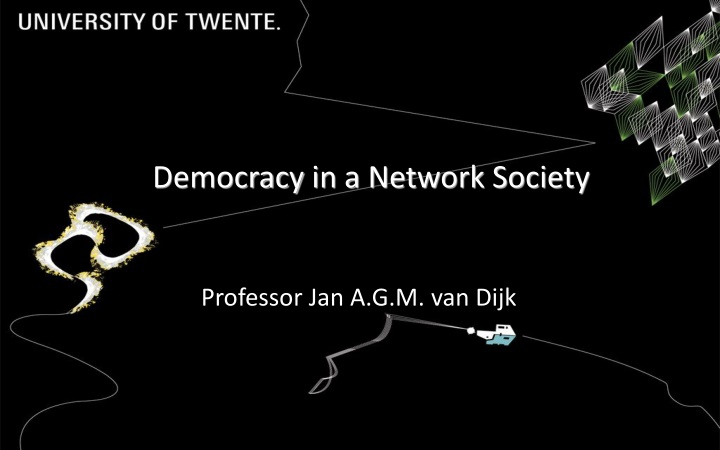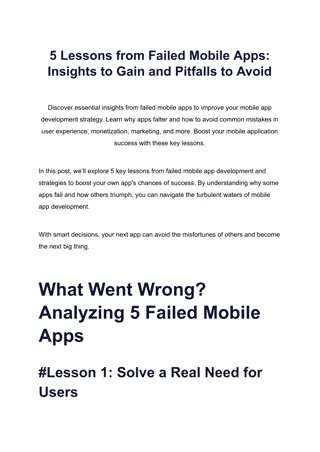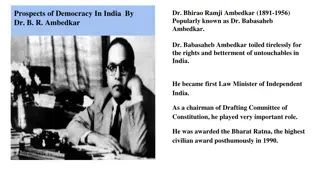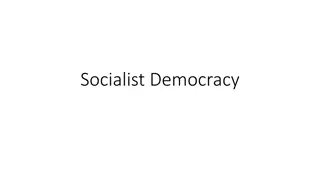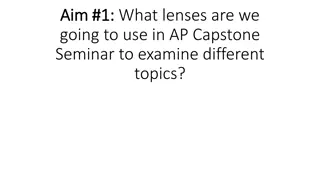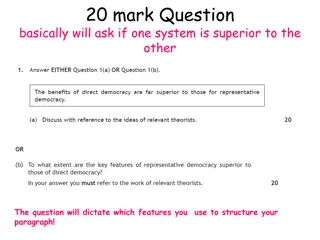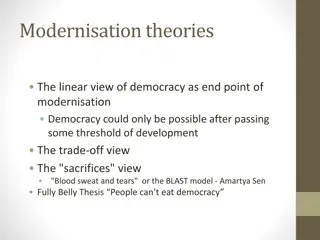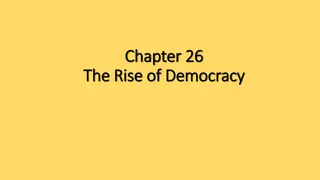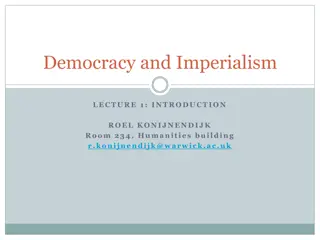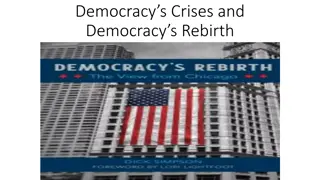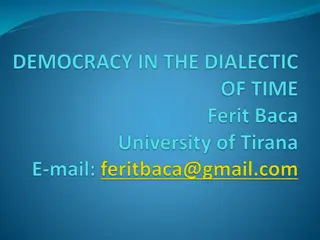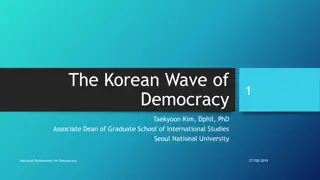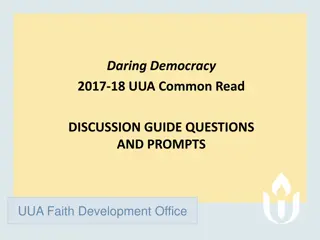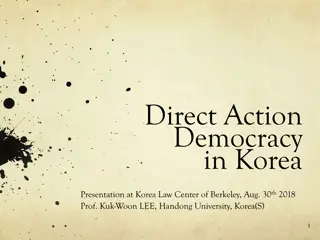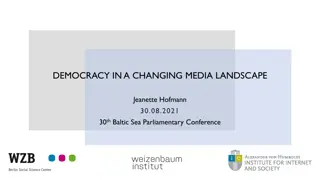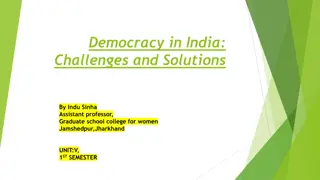Digital Democracy in a Network Society: Promises and Pitfalls
In "Democracy in a Network Society" by Professor Jan A. G. M. van Dijk, the concept of digital democracy is explored, focusing on promises made in the 1980s and 1990s. The text discusses the definition of digital democracy, potential pitfalls in thinking about technological transformations, and the fulfillment of promises related to information retrieval, public debate, community building, media participation, and citizen involvement in decision-making. Reflecting on the evolution of democracy in the digital age, the text raises questions about the actual impact and effectiveness of digital tools in enhancing democratic processes.
Download Presentation

Please find below an Image/Link to download the presentation.
The content on the website is provided AS IS for your information and personal use only. It may not be sold, licensed, or shared on other websites without obtaining consent from the author.If you encounter any issues during the download, it is possible that the publisher has removed the file from their server.
You are allowed to download the files provided on this website for personal or commercial use, subject to the condition that they are used lawfully. All files are the property of their respective owners.
The content on the website is provided AS IS for your information and personal use only. It may not be sold, licensed, or shared on other websites without obtaining consent from the author.
E N D
Presentation Transcript
Democracy in a Network Society Professor Jan A.G.M. van Dijk
Program 1. Definition of digital democracy 2. Promises of digital democracy in the 1980s and 1990s - Promise and reality (1) information retrieval and exchange - Promise and reality (2) debate and community building - Promise and reality (3) participation in the media, example: the social media - Promise and reality (4) participation in political decision making 3. Why could we be so wrong? Pitfalls of thinking about transformations by technology - Pitfall 1: The idea of a total revolution - Pitfall 2: The assumption of social continuity - Pitfall 3: The technical fix for basic problems - Pitfall 4: Instrumentalism (digital media are simply tools) 4. General conclusions
1. Digital Democracy: Definition A collective use of digital media and networks for politics, online and offline or combined, with a particular view of democracy Van Dijk, Jan & Hacker, Ken (forthcoming) Democracy in a Network Society The use depends on views of democracy existing before: Substantial - Liberal democracy (conservative, market, social) - Populist (right-wing/ left-wing) - Authoritarian democracy (?) (religion, military, one-party rule combined) Formal/strategic - Legalist - Competitive - Pluralist - Participatory - Plebiscitary - Libertarian
2. Four Basic Promises (80-90s) 1. Improvement of political and government information retrieval and exchange 2. Support of public debate, deliberation and community building 3. Enhancement of participation in the media: Participatory media e.g. Social Media and Civilian Journalism 4. Enhancement of participation in political decision making by citizens (= teledemocracy )
Promise 1: Information Retrieval and Exchange Has been fulfilled! - Huge amounts are available, up-to-date and relatively easy to find. Websites, Facebook pages etc. - New tools such as voting guides. - Politicians directly reached by mail and SNS. But also: - Information overload and lack of information skills for many citizens. The political elite in fact still has better access - Does information actually lead to political action? - Decisions are not necessary improved by getting information Decisions are ultimately matters of judgement. - Lack of response (by officials): reachablity is not equal to (real) approachability. Reachability often used as a buffer!
Promise 2: Debate and Community Building Partly fulfilled There are millions of debates, chats, social media talks. Much more than in outlets before the digital era They must have some effect on citizens knowledge and on public opinion for sure! But: Unequal participation: more by well-educated and politically informed; less by the uninformed and often by women who favor electronic discussion less than males Group dynamics: e.g. those right have no more influence than those wrong Few results (conclusions and consensus are achieved less in online than offline groups) No or minor influence on official politics!!
Promise 3: Participation in Digital Media Partly fulfilled Enormous growth of weblogs, personal websites, online papers partly filled by readers. Some times important scoops and reports of citizens about abuses, corruption of politicians etcetera Rise of the social media as a new political channel for everybody SENDERS SUPPLIERS PROVIDERS NETWORKERS USERS But also: - Media companies keep in control (affecting input of users) - Questions about professionalism of input (fact versus opinion) - More elite participation than average citizen participation RECIEVERS
Social Media Participation: Advantages 1. A new channel for finding political news, to discuss and to organize or mobilize. Access and voices heard for people being silent before: people with low education and political interest 2. A direct channel between citizens, representatives and politicians. Bypassing the traditional media as gatekeepers 3. Mobilization power: for demonstrations, meetings and even revolts (Arab Spring) 4. Campaign tool in elections: political advertising, finding volunteers, small donations
Social Media Participation: Disadvantages 1. Unreliable: fake news and other disinformation. Platforms (e.g. Facebook) refrain to become editors, say they are only carriers. Fact, opinion and fiction (lies, fake ) are blurring. 2. Manipulation of messages and followers. Twitter bots: 1/3th of tweets of Trump in the campaign was written by a robot, and 1/5th of Clinton s. Followers are simply bought. 3. Personal and emotional style of communication. Plus: brings politics better to the people; minus: politics as serious and rational affair is weakened. Emotions such as scolding and jeering occur. 4. Discourse leads more to polarization than to agreement 5. People are stuck in a filter bubble : only messages in your timeline that agree with you (habitual exposure thesis against the accidental exposure thesis: surprises)
Promise 4:Enhancement of citizen political decision making Not fulfilled at all - Direct democracy collides with the structure of our political system (= representative democracy). Referenda are contested. Results of so-called e-participation projects mostly achieve no response by governments. - Direct democracy (by digital media or not) is difficult to realize in a complex society. The call for teledemocracy of the 1980s is silent now. However, the future will be some combination of direct and representative democracy. Because of the fast and interactive properties of computer networks. - Facebook , Twitter etc. are powerful instruments of mass mobilization, but not of organizing, certainly not revolutions (Arab Spring turns to Winter). Authoritarian governments strike back in many ways, also using Facebook, Twitter etc.
Conclusion So Far (What about the Future?) So far, the practices of digital democracy do not fill most promises because they do not touch the basic structures of the political system. They show new forms, channels and contents (discourse) but not institutional changes Most is business as usual . For example: only the forms and techniques of election campaigns may change but not the strategies and tactics, not even grass-root participation. Where did these blown up expectations come from? This is the second part of my presentation: pitfalls of thinking about the transformation of technology (inspired by Joseph Corn, 1986)
Transformation Pitfall 1: Idea of a Total Revolution Assumption that new technologies will radically change our lives, in this case the political system Many cases in history: - Electricity (1850) would bring power to every house and freedom for individuals. Result: rise of massive bureaucracies - Radio (1910) everybody would become a broadcaster. Result: dictators (e.g. Hitler) brainwashing people. Rise of communism and fascism - Television cable (1980) remote tele-voting and choices from home. Result: no votes by television today; 100+ TV-channels and nothing-on , but commercials Mistake 1: technological opportunities simply transformed to social realities; revolutions rarely happen Mistake 2: often it is simply wishful thinking
Transformation Pitfall 2: Assumption of Social Continuity Assumption of mere improvement of things and technologies, only faster and stronger, no basic changes Many cases in history: - The car was an improved coach - The internet was an electronic highway - Social media is just more effective marketing (personalization) Mistake 1: underestimates the slow but effective transformation potential of new technology in the long term. Example: social media breaking a totalitarian system such as China Mistake 2: technologies can be disruptive (fast): networking in the economy and politics (eg. rise of the social media)
Transformation Pitfall 3: A Technical Fix for Complex Problems Assumption that digital media can easily fix problems which in fact are deep and complex. Many cases: - The Internet or social media fixing problems of democracy such as a lack of political motivation, knowledge, efficacy and turn-out - Social media overthrowing authoritarian regimes by mass mobilization ( Twitter and Facebook Revolutions ) Mistake 1: These are superficial solutions. Much more is needed to change this, for example not only to mobilize but also to organize reform or revolt (social media are more individually used, less collectively: to organize parties etc.) Mistake 2: A bias: only positive fixes, no negative effects or second order effects (not expected)
Transformation Pitfall 4: Instrumentalism Assumption that digital and social media are only tools that can be used for any purpose, good or bad. For liberty and for control or surveillance. Mistake 1: This assumption is much too simple. Communication technologies are neither empty vessels to be filled with products of human intent nor forces unto themselves, imbued with some kind of irresistible agency. (Deibert & Rohozinsky, 2013). The effects of the Internet are complex and continually evolving. Also contingency rules. Mistake 2: Only the use of digital media might have effect, never as a tool by itself. Only in particular circumstances , to be investigated.
General Conclusions 1. The promises of digital democracy are scarcely realized yet. 2. So far, digital democracy has not basically touched the political systems of America, Europe, Arabia and China. 3. The digital media have a very modest positive effect for participation, especially for young people, but not enough (political interest is more important). You can win elections when you are good in digital/social media. Not a boost for democracy as a whole. 4. The use of digital media can support and destroy democracy (disinformation, surveillance, micro-targeting marketing) 5. Basic changes may occur after a long time-span. They will be different than we will expect now, with our poor assumptions of a total revolution, social continuity, technical fix and instrumentalism.
